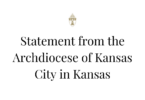by Joe Bollig
joe.bollig@theleaven.org
ST. BENEDICT — You know you’re in a very Catholic place when both the parish and the town are named after saints.
That’s St. Mary Parish in St. Benedict, in Nemaha County.
“I would say that this is probably one of the most Catholic areas of any parish I’ve been in,” said Father Edward Oen, CPPS, pastor for a little less than a year. “I’ve always asked [to serve] in rural parishes, but I’ve never seen anything like this, where it’s almost all Catholic.”
St. Benedict could have become famous as the “other home of the Wildcats,” because it was originally named Wildcat Creek for the abundant creatures that prowled the region in pioneer times.
Instead, St. Benedict’s claim to fame is its elaborately adorned St. Mary Church, which was placed on the Kansas Register of Historic Places in 1977, and named to the National Register of Historic Places in 1980. It was also a finalist in the Eight Wonders of Kansas Art contest in January 2008.
St. Mary Parish reached another milestone on Sept. 26, when it celebrated its 150th anniversary. The parish observed the historic occasion with a Mass celebrated by Archbishop Joseph F. Naumann. Father Edward, who is also pastor of Sacred Heart Parish in Baileyville, concelebrated.
Other concelebrants, from St. Benedict’s Abbey in Atchison, were: Abbot Barnabas Senecal; and former pastors and retired abbots, Owen Purcell and Ralph Koehler. Several Benedictine Sisters from Mount St. Scholastica in Atchison were also in attendance.
In his homily, Archbishop Naumann praised parishioners for being faithful successors in a long tradition of faith, symbolized so beautifully by their church.
“This church is a beautiful testament to the depth of the faith of those who built it,” said the archbishop. “Our buildings really do reveal the priorities in a community and society. The Catholics who built this church expressed and spread the word that nothing was more important to this community than God.”
“Our churches also reflect our understanding of ourselves as well,” he continued. “We believe that we are the very temples that carry the life of God. We believe that our human dignity is greater than any other creature because we have been uniquely fashioned in the very image of God. Our churches are built to provide the space to make present the sacrifice of Jesus on Calvary.”
After the Mass, parish children passed out 150 balloons to parishioners, who participated in a group photo and balloon release. Another photo of worshippers was taken on the north side of the church.
Afterward, a catered dinner was held in the parish dining hall. Historical displays featuring photos, artifacts, and documents were featured upstairs in the gymnasium.
“We had a lot of the older [pre-Vatican II] vestments, a tabernacle from one of the previous churches, a canopy carried during Corpus Christi and other celebrations, holy water fonts, and a number of photographs,” said Elmer Ronnebaum, who was also on the committee to produce an anniversary book.
The book, “St. Mary’s Catholic Parish – St. Benedict, Kansas – 1859-2009,” contains a parish history, full-page photographs of 120 parish families, and some information about each family.
St. Mary Parish was founded in 1859, just two years before the outbreak of the Civil War. The St. Joseph-California Road, part of the Oregon Trail, passed only two miles to the north.
Down this road came the first homesteading families, and the area attracted Catholic German and Irish settlers in 1858. In 1859, a delegation traveled to St. Benedict’s Abbey to ask that a priest occasionally visit the town to administer the sacraments. For years, the settlers were lucky to have a priest there to say Mass twice a year.
Although a rectory had been built as early as 1861, the parish did not receive a resident priest until 1883; even then, he had several missions to minister to as well.
There have been four churches to serve the parish in its history. The first, built in 1859, was a small wood frame building. Work on the current church was begun in 1891, when parishioners began quarrying nearby limestone deposits. The cornerstone was laid on April 30, 1893, and the completed church was dedicated on Nov. 14, 1894.
Over time, the bare church was adorned with more than 30 statues, paintings, murals, and stenciling. In 1901, George F. Satory turned his hand to the murals and stenciling. At the same time, Thaddeus Zykotynski painted 14 oil paintings for the church.
Restoration projects — in 1941 to 1942 and from 1970 to 1983 — were undertaken to preserve the artwork. Today, St. Mary Church is the only church to preserve the work of Satory. Over the years, work has also been done to the rafters, roof, steeple, stained-glass windows, heating and cooling, electrical, sidewalks, plaza, and the grotto.
Maintaining the church is expensive for a small parish, but it is being done for a good reason: It’s the parishioners’ way of carrying the faith forward into the future. It’s also why they are celebrating the parish’s 150 years.
“What they’re doing is carrying on a long tradition of catholicity, and they are celebrating their Catholic faith,” said Father Edward.
Long-time parishioner Ferd Deters concurred.
“It shows we still have our faith, and our parish is held together by that faith. And that’s why it was so important for so many people to come and participate in this celebration,” he said.






